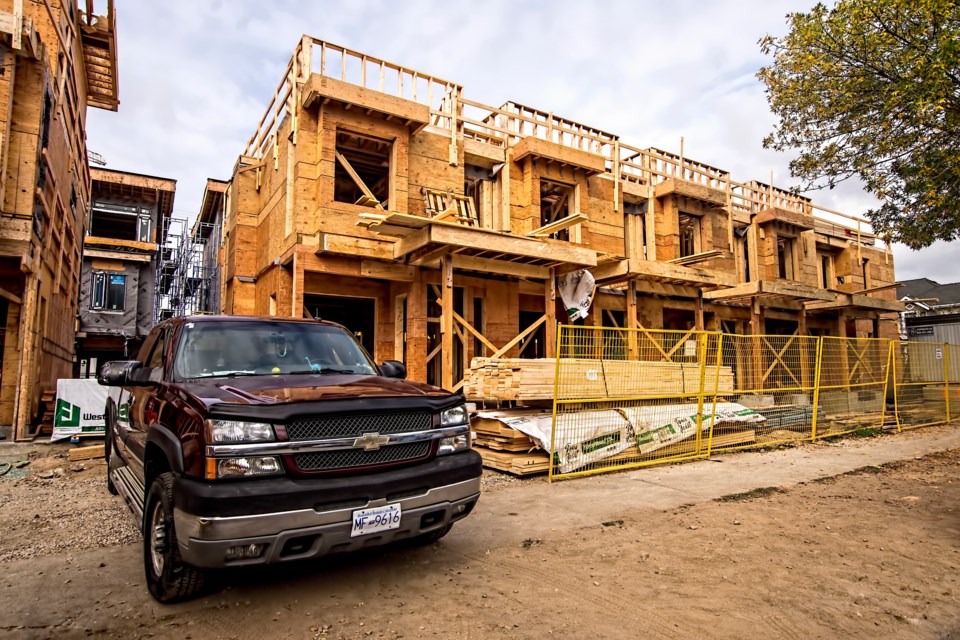For a plan that’s been almost a year and a half in the making, Premier David Eby’s marquee public housing program, BC Builds, landed with an unimpressive thud Tuesday.
What had been billed as the centrepiece of the NDP’s ambitious housing agenda, and one of Eby’s biggest promises during the 2022 NDP leadership campaign, ended up debuting as a vague, small-scale, underwhelming initiative built largely upon $2 billion in recycled funding from the shuttered BC HousingHub.
The launch consisted of 400 apartments in three projects located on public land in North Vancouver, Duncan and Gibsons. Construction could start this summer.
Maybe.
And there might be another 17 other projects, representing 3,600 more market rental units for middle-income British Columbians, sometime in the next three to five years.
The money was accompanied by a flashy new logo and a lecture from the premier about the failures of the previous BC Liberal government’s partnerships with the private housing sector. It felt more like an election event than a housing policy launch.
“When governments decided to … leave the business of housing entirely to the private sector, the results were unfortunately predictable,” Eby said. “Speculators ran wild.
“Rent started going up, the cost of purchases started going up, and the outcome was very, very negative for real families in our province. Our government is not taking that approach.”
That would be an easier sell if rents and home prices hadn’t skyrocketed under the last seven years of the New Democrat government too.
BC Builds hardly looks like the panacea. A five-year plan to create 4,000 rental apartments equates to barely a rounding error on the 250,000 British Columbians who spend more than 30 per cent of their household income on housing and could use some assistance.
The NDP hopes its other reforms, including short-term rental restrictions and legalized secondary suites, will eventually add up, too. But the gap will likely have to be filled by that private sector the premier was so quick to disparage.
Still, BC Builds does hit upon a voter segment New Democrats have long neglected in aid packages: The urban middle class.
Most NDP rental assistance programs have to this point been geared toward the homeless, at-risk and low-income British Columbians.
BC Builds will offer market rental one-bedroom units for people who make up to $131,950 annually, and two-bedrooms for households with combined incomes of up to $191,910.
“I think that many British Columbians have looked at government and said, well it’s good the government is looking after people who are struggling in the streets with homelessness and living at parks, but you know, I earn a decent income, our family has $100,000 or $130,000, there’s nothing for us, we’re looking around and we can’t find anything to rent,” said Eby.
“This is the story that we’re hearing again, and again. This is the group of people that this program is targeted at.”
The BC Conservatives and BC Greens both criticized the demographic, accusing Eby of helping subsidize those who don’t need it at the expense of those who do.
Only BC United, whose electoral fortunes also depend upon swing middle-class urban voters, tempered that criticism, instead focusing on what it called a “government-knows-best” construction model that will fail without the private sector.
Still, the income levels represent the correct target audience for the NDP going into an election, especially in Metro Vancouver ridings. While there won’t be actual rental units for voters to see, the promise of affordable housing for middle-class voters previously excluded from provincial rental assistance will be a powerful lure for New Democrat candidates to dangle over the head of cash-strapped British Columbians when the writ drops.
As for the rest of BC Builds, there’s no point even bothering to explain how it will work. In many areas, it’s clear the government doesn’t even know.
How many British Columbians will qualify for the program? “Many,” said ministry officials during a technical briefing. Translation: No clue.
How will the government test renter income? We’ll figure something out, said the ministry.
How will it ensure the units are reserved for locals first, as promised? Check back later, was the answer.
What are the market rent levels the province is targeting? To be determined.
How many units can be subsidized to 20 per cent below market rates with the extra $1 billion the province is kicking in for that purpose? We don’t know, admitted the housing ministry.
And so it went. There are half-baked programs, and then there are programs where government hasn’t even written down the list of ingredients yet, let alone mixed them together and put them in the oven. BC Builds is definitely the latter.
Normally, this level of sloppiness would be surprising when it comes to the Eby administration, especially when you consider the premier first sketched out the broad strokes of this program during his party leadership bid in September 2022.
But the launch of BC Builds in some ways also represents the first tentative foray of the NDP into its re-election campaign. There’s no steak here, only sizzle.
You have to re-elect the BC NDP to actually build anything of substance. And even then, it’s not clear this tiny, poorly explained program would make much of a difference anyway.
Rob Shaw has spent more than 16 years covering B.C. politics, now reporting for CHEK News and writing for Glacier Media. He is the co-author of the national bestselling book A Matter of Confidence, host of the weekly podcast Political Capital, and a regular guest on CBC Radio.





